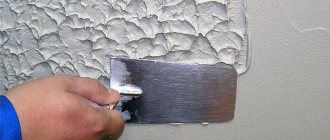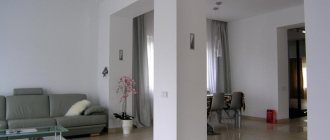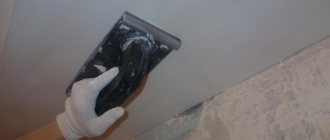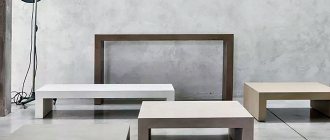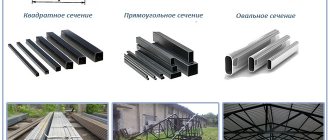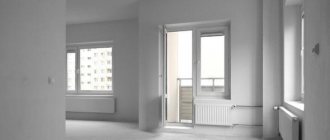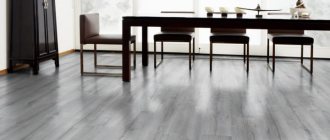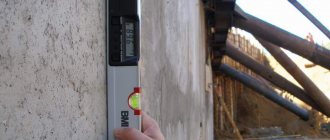What are the differences between putty and plaster?
Before finishing, walls made of brick or concrete must be leveled. Gross defects are corrected with plaster, which consists of coarse-grained components and fills all the defects. But still, the plastered surface is still far from ideal.
For the final leveling of walls or ceilings, putty is used. It contains finely ground particles a fraction of a mm in size. First, the starting treatment is carried out, then the finishing treatment. As a result, the surface becomes smooth and suitable for applying wallpaper or paint coatings.
Controlling the evenness of walls and the main methods for leveling them
You can check the evenness of the base using a long rule, which is applied to the wall and the amount of difference is determined by the gap between them and the surface under study.
Permissible deviation is 1-1.5mm. In this way, the entire area of the wall is checked. When large differences are detected, they are leveled in different ways.
Leveling walls with plaster
For differences of more than 5 mm, the walls can be leveled with thin plaster. It is necessary to install beacons for even application of the solution to the surface. When eliminating differences of more than 20 mm in height, it is necessary to reinforce the plaster with a mesh so that it does not crumble. How to plaster on beacons: the solution is thrown onto the wall, and then leveled with a spatula or trowel. Then this layer must be coated with a primer. There are also ways to level walls without beacons.
To prevent the plaster composition from crumbling, it is reinforced with reinforcing mesh
Putty is a convenient material for decorating walls
The putty mixture can be used not only as a base for other finishing materials, but also for the production of decorative plaster. It is flexible, holds its shape well, and does not blur. After drying, a mechanically durable coating is formed that can be painted, varnished or glazed.
The composition of putties can be cement, gypsum or polymer:
- cement ones are intended for finishing wet rooms and facades;
- gypsum absorbs moisture, so they are used only in dry conditions;
- polymeric ones are universal, do not shrink or crack.
To create texture, decorative elements are added to the mixture - marble chips, coarse quartz sand, various fibers, polymer chips. Combinations of these components of different sizes give an interesting relief. Additionally, pigments and glitter are used - finely chopped sparkles that create a slight shimmer.
Due to the fine structure and plasticity of the material, the design is easily formed even without decorative inclusions. The texture can be created with the most common tools - a grater, spatula, roller or just your fingers.
Terrasite plaster has high strength. It is used for finishing plinths and facades. In addition to frost-resistant cement, it contains granite chips and stone flour, which perfectly resist mechanical damage.
Other necessary tools
You can apply the pattern using other devices:
- Putty knife . The material and shape can be very diverse: stainless steel, plastic. There are a variety of coating techniques. It all depends on your imagination and taste. A notched trowel, for example, will make it possible to make parallel lines in a checkerboard pattern.
- Master OK . With it, like the most ordinary spatula, you can create an original, unusual pattern using chaotic movements.
- Stencil . It is appropriate to mention this tool as well. They can produce not only simple abstract patterns, but also almost paintings and bas-reliefs. The stencil can be attached to the wall, or it can be made in the form of a paperweight - it is used to create a pattern or picture. Before you get ready to apply any image, you need to make a precise choice and purchase the right stencil.
In addition to the listed tool, you can use a lot more, from a paintbrush to a Venetian trowel (trowel). Even a simple broom can give a wall a unique design.
Advantages and disadvantages
Finishing mixtures have high adhesion to stone, concrete or metal, are easy to apply and harden quickly. They are made with the addition of plasticizers, which facilitate convenient application and the formation of a decorative texture.
High-quality plasters are much superior to both wallpaper and painting in a number of characteristics. They provide:
- reliable protection of walls;
- attractive appearance;
- durability and maintainability.
The disadvantages include:
- the need for preliminary leveling of the surface;
- high price of professional services;
- labor-intensive dismantling in case of changing the coating.
Of course, the installation of decorative plaster cannot be called too simple, but having mastered some techniques, it is quite possible to do it yourself.
Stages of work
Before applying the finish, all dirty or dusty work is completed, electrical wiring and other communications are completed. The room temperature should not fall below +5°.
Decorative putty plaster is made in the following sequence:
- Surface preparation. Although due to the texture it is possible to hide some flaws, large defects will still be noticeable. Therefore, the base needs to be leveled, puttied and primed.
- Preparation of putty (when using a dry mixture). Cement and gypsum compositions are diluted with water according to the manufacturer's recommendations. Polymers are usually produced in finished form.
- Applying the mixture using tools, forming the relief. The design can be graphic or imitate various textures - marble, wood, masonry, sea waves, etc.
After complete drying, if necessary, light sanding and final finishing with paints and varnishes are carried out. To make the texture brighter, paints are applied in several layers and rubbed over the surface. Compositions with a metallic shine effect give a special shimmer.
Installation of beacons
Previous measures to prepare walls for plastering may be ineffective if this stage is not performed correctly. Key notes and tips on the issue:
- Beacon pitch recommended for beginners: 0.8-1.3 m;
- distance from door and window openings: 0.1-0.15 m;
- metal beacons are removed after the composition has set, all others remain;
- wooden ones are not recommended in rooms with high humidity;
- plastic ones are easily deformed, so they are relatively difficult to install.
Algorithm of actions when placing beacons:
- Perform markup.
- Set guidelines for the outer beacons.
- Create an auxiliary strictly vertical plane using laces and a level.
- Determine the level of deviation of the wall from the auxiliary plane.
- Correct the auxiliary plane.
- Set the extreme profiles.
- Install intermediate beacons.
To perform installation, you may need metal scissors, a plumb bob, a marker, a hammer drill, a screwdriver, and pliers.
Remove the previous layer, clean, degrease, install reinforcing tape and beacons - this is how you need to prepare the walls for plastering. Additional steps will be required for some types of partitions. The metal structure is roughened, and notches are made on the brick or concrete structure.
How to properly prepare the surface
The more even and durable the base is under the plaster, the better it will lie and the longer it will last. There is no need to level it perfectly - small defects will be filled with a decorative mixture, and the drawing will visually hide other defects. Large imperfections must be smoothed out with cement or gypsum mortar.
Before applying decorative putty, the walls are cleaned of old cladding, the bumps are cut off, and the surface is treated with a deep penetration primer. This improves the adhesion of materials and reduces the absorption of moisture from the putty.
It is recommended to make test samples of various types of plaster in advance, and also paint them in the chosen color. It is possible that the paint will look different in specific lighting and the pigment will need to be replaced or adjusted.
Removing contaminants
The process of preparing walls for plastering with your own hands must necessarily include cleaning the working surface from soot, fungus, greasy and chemical stains, dirt and dust deposits - from anything that interferes with adhesion.
| Type of pollution | Removal method |
| Dirt and dust | Mechanical, metal brush. |
| Oil (not wood wall) | A thick layer of oily clay is applied to the contaminated area. After hardening, it is cleaned off. The action is repeated until the stain completely disappears. If the method does not help, the surface is treated with a solution of hydrochloric acid (3%) and then washed several times. |
| Oil (wooden wall) | The oil-soaked area is cut down. |
| Fungus | Check and repair the ventilation and air conditioning system. Ventilate the room thoroughly. Treat the affected areas with a biocide. After drying, coat all walls and corners, including uninfected ones, with the product. |
It is not recommended to apply a new layer of putty over an old one that is infected with mold. First you need to remove all affected areas, debug the ventilation system and detect the source of moisture.
Recipes for making plaster from putty
The classic mixture is made with the addition of water. But for decorative purposes, greater viscosity is required, which can be achieved using various substances.
With PVA glue
Polyvinyl acetate glue is a viscous white or cream-colored liquid. It is used for gluing paper materials to various surfaces, and also as an additive to mortars.
To prepare decorative plaster, first mix the putty with water, then add glue. As a rule, dry ingredients are poured into water, and not vice versa. Depending on the volume of the solution, hand tools, drill attachments or construction mixers are used for mixing.
PVA, as an aqueous dispersion, quickly dissolves in putty. After a few minutes you can begin applying plaster to the wall. The life time of such a mixture is no more than 3-4 hours.
With primer
To increase the workability period and increase ductility, craftsmen completely replace water with a primer.
Mixing the putty is done as usual. It is recommended to add the liquid component in portions to achieve the desired consistency.
This plaster adheres well to the surface and forms a strong monolith. After hardening, it becomes more durable than on water.
From gypsum putty
A gypsum mixture is quite suitable for finishing dry rooms. It has high vapor permeability, so the walls “breathe” without accumulating condensation from the air.
To prepare plaster from gypsum putty, craftsmen advise mixing “start” and “finish”. This mixture forms well and “holds” the pattern. The starting putty alone is a bit rough, and the finishing putty is too soft. Their mix has all the characteristics necessary for plastering.
With stone chips
Marble plaster is not cheap. It contains many components that provide not only strength, but also good adhesion to various surfaces, resistance to ultraviolet radiation and moisture. Up to 1/3 of the volume is occupied by ground marble, granite, tuff or limestone. Due to this, the coating resembles natural stone and is not inferior to it in strength. For shine, mica is included (up to 2%), color is provided by pigments.
Marble plaster is sold ready-made; it only needs to be slightly diluted with water (1-1.5 liters per 25 liters of mixture). Everything is mixed at low speeds. To prevent the base from showing through, the primer for such a finish should be the same color as the decorative coating.
You need to apply the composition with stone chips to the wall in one go, from corner to corner, so that there is no difference in shade. The raw material is carefully smoothed to fill all voids. The color begins to appear as it dries.
Second stage: do-it-yourself wall repair for plaster before finishing
After removing the coating, you should carefully inspect the walls. They have cracks, chips and damage. Any existing defects should be eliminated.
Repairing reinforced concrete panels is no different from restoring concrete floors. Loose elements in brickwork should be removed, and the cement mortar on the sides and top should be beaten off. Then lay the bricks back on the cement and sand mixture. It can be replaced with polyurethane foam.
Expand small cracks to fill with mortar. Reinforce large ones with self-tapping screws and use “cement laitance” - a mixture of cement and water in a 1:1 ratio. The composition can be replaced with a penetrating primer.
Use the mixture to seal the slotted edges to prevent their destruction in the future. Ensures adhesion to the repair mortar. Seal the cracks with it after the primer mixture has dried. Remove chips and unevenness using the same method.
Non-through cracks in aerated concrete should be reinforced and sealed with putty. It is necessary to prepare a gypsum solution from a special finishing mixture (for example Knauf HP Fin).
Techniques for applying putty plaster
We offer several techniques that require not only time and labor, but also artistic taste. As a rule, walls decorated in this way go well with smooth, plain surfaces. To make a bright accent, small areas are sometimes covered with labor-intensive plaster.
Venetian
This is a rather complex technology, but the result is a spectacular imitation of polished marble with a fantasy pattern of veins, beautiful color tints and a silky shine.
If you are ready for a difficult task, we suggest performing a three-layer finish using putty in 2 colors:
- Prepare the wall as for wallpapering, that is, level and prime.
- Divide the gypsum putty into 2 parts. Add pigment to one, the other remains white.
- Using a plaster trowel, onto which small portions of a colored and white mixture are applied, perform the first layer - broaching. To do this, randomly rub the mass in different directions to create streaks and streaks.
- Allow the first layer to dry, sand the tool marks with sandpaper.
- Apply the second layer in the same way, but make smaller portions of the solution. Grind everything thoroughly.
- When the coating is completely dry, trim with a solution of both colors. With short movements of the trowel with additional rotation, the material is distributed over the surface in a random order.
- To ensure that there are no boundaries between areas, treatment should be carried out in areas of 1-1.5 m². Carefully smooth out color differences and burrs from the spatula.
- Dry the wall, sand all sharp edges and burrs with sandpaper.
- Remove dust from the surface and coat it with a deep penetration primer.
Apply a decorative coating to the finished Venetian plaster - wax, glaze, varnish. To create a transparent glazing effect and achieve a deep iridescent color, you can add ground mother-of-pearl, silver or gold. Glitter sparkles will add elegance and brightness.
Moroccan
This is an amazingly beautiful glossy smooth plaster, known as tadelakt. It is performed using the following technique:
- The substrate is coarse-grained lime plaster without compaction.
- The surface is coated with casein primer in 2 layers in a cross direction so that there are no smudges.
- The plaster is applied in 2 steps without smoothing, then a third, more liquid layer.
- After setting, the polishing stage begins. It is carried out with a smooth stone. The result should be a glossy surface with water-repellent properties. When polishing, the sound resembles the friction of stone on stone, which indicates the high hardness of the finishing coating.
- The surface is covered with a special polishing soap and finally sanded. If during operation there is direct contact with water, you need to polish again.
You can make a multi-color coating if you use mixtures from different palettes. The design is applied in stripes or multidirectional strokes and then polished with stone.
There is also a technique of applying with a sponge, when instead of a smooth surface you get a textured one. The grooves are filled with wax, everything is polished with a grinder, and then by hand. This coating is very similar to Venetian multi-layer plaster.
"Bark beetle"
This is one of the most popular types of decorative finishing for exterior and interior work. It is easy to apply and economical in material consumption. The surface is covered with small winding grooves and looks like wood eaten by bugs. The similarity gave it the name “bark beetle” in “honor” of the woodworm of the same name.
A specific pattern is formed during the plastering process with a mixture of small granules. You can set the direction of the “moves” yourself.
The base can be made of gypsum, liquid glass or polymer. Release form: dry mixture or paste. After application to the surface, the mass should not remain motionless. It is moved using a plastic trowel in the selected direction - vertical, horizontal, in a circle. At the same time, solid particles cut grooves, creating a characteristic relief texture.
Movements should be light, sliding, without pressure. The granules must not be deformed or damaged. If the composition contains pigment, coloring is not required. You can coat the surface with a strengthening acrylic varnish to make it waterproof.
"A Thousand Lines"
The decorative material is made from ordinary putty (it is better to use ready-made acrylic-based paste) and quartz sand with a grain size of up to 1 mm. The granules are added gradually, in small portions, and the mixture is thoroughly mixed each time.
The color for the primer and putty is selected as accurately as possible to avoid showing through the underlying base. The brush for forming the pattern is made from a construction float and a plastic shoe mat with a needle-shaped surface, which is sold in stores by the meter. A piece of the desired size is simply cut out and glued using epoxy glue. The edges of the nozzle must be secured with self-tapping screws.
Markings are made horizontally on the wall so that the lines are straight and do not slide. To do this, segments 2 brushes wide are marked, and masking tape is glued along their borders. The result is horizontal stripes of the same height.
Next, putty with a thickness of at least 1 mm is applied to the areas, which must be brushed over. Grooves will remain on the surface. Irregularities are carefully smoothed out with a spatula.
The masking tape is removed as the areas are processed, and each subsequent strip is formed overlapping the previous one. Due to this, there are practically no joints.
Then you need to leave the plaster to dry for at least a day. Lightly sand with fine sandpaper and apply glaze, spreading it along the stripes. It is recommended to use material with glitter. It will highlight the structure of 1000 lines and give the interior a touch of luxury.
How to make decorative putty: simple techniques
If Venetian or Moroccan plaster requires skill and time, then some reliefs can be made with your own hands very quickly. This does not require expensive materials; ordinary putty and simple devices are sufficient.
Curly roller
With the help of structured rollers you can cover even a large area in a short time. Their surface can be rough, fleecy, with a geometric or naturalistic pattern, for example, wood or leather.
Homemade devices are also used. To make them, ordinary foam rollers are converted into structural ones - they are wrapped with ropes, plastic film, a pattern is applied to the surface using a silicone glue gun, etc.
When forming a decorative coating, a layer of putty 1-3 mm thick is applied to the wall. The roller is moistened with water and rolled over the damp surface in a certain direction or randomly.
Processing continues until a characteristic uniform pattern appears on the wall. After drying, the surface is lightly sanded and painted as desired.
Masking film
This is a simple and inexpensive way to create an interesting “crinkled” pattern on the wall:
- Tint the putty for the base layer in the chosen color and apply evenly to the surface.
- Cover the putty with masking film, smooth it with your hands and form a relief. Additionally, treat with a roller.
- After 24 hours, carefully remove the film, wipe the surface with a grout mesh, remove dust and prime.
To secure it, tinted azure is applied. To emphasize the relief, excess from the protruding parts is removed with a plastic spatula.
Using a stencil
Stencil plaster requires painstaking work and considerable patience, which is why master finishers charge a lot of money for the work. But you can do something similar yourself.
You will need a thick stencil, which you can make yourself or order from a workshop. The surface of the wall must first be primed with a high-quality primer and puttied to match the finish. The base can be perfectly flat or with some deviations (for subsequent filling with Venetian). A little Marrakech on the plaster will only decorate it.
The stencil is glued to the wall using masking tape. The slots are filled with a modeling mass of a different color from the base. You can use a solid color mixture and then paint the reliefs or cover them with gold. After the putty has dried, sand off the burrs and finish the wall completely.
"Fur coat"
The mixture for this plaster is made on an acrylic base with the addition of sand and ground rocks. They give the surface its characteristic “fur” appearance.
Compositions for “fur coats” are plastic, easy to apply, and not prone to shrinkage and cracking. You can tint the entire mass at once or paint the surface after the solution has dried. The pre-treatment primer should contain quartz to ensure good adhesion of the materials.
To apply the “fur coat” you will need a trowel and a metal grater. For the first layer, the mixture is distributed evenly over the wall with a thickness of no more than 1 mm.
Next, the desired drawing is formed:
- A portion of the solution is applied to the spatula and lightly smoothed with a trowel.
- The spatula is applied to the surface, pressed and torn off. Movements are made chaotically.
- Begin processing each subsequent section before the already applied putty dries, in order to avoid the visibility of joints.
- After the plaster has dried, remove sharp ridges with sandpaper.
The coating can be washed, repainted, and damaged areas can be repaired.
What equipment will be needed?
The exact list depends on what the wall is made of, as well as on the covering to be removed. Theoretically, when preparing walls before plastering, the following tools and devices may be useful:
- protection (respirator, gloves);
- spatulas (wide, narrow, medium, one of them should have a long, strong handle for use with a hammer);
- sandpaper (coarse mesh);
- drill (a mixer attachment is required);
- level and plumb;
- chisel (relevant for plastered walls; it is better to give preference to a model with an extended handle);
- polyethylene film;
- hammer;
- knife;
- sponge, rag, bucket;
- screwdriver;
- wide brush;
- perforator;
- bags for construction waste (durable, spacious);
- brush, broom, dustpan (for collecting garbage);
- masking tape or tape.
If there is wallpaper in the room, then before removing it you should stock up on a sprayer. It is much more convenient for them to soak the canvas than with the usual wet rags moistened with a brush.
List of required materials:
- solvent;
- primer (responsible for improving adhesion);
- putty (designed to level the surface).
When working with perfectly smooth walls, you can do without the last product, and a solvent is not needed if there are no painted structures.
